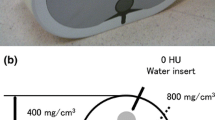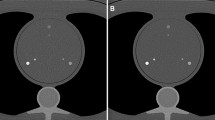Abstract
The aim of our study was to evaluate attenuation-based tube current adaptation in coronary calcium scoring using ECG-gated multi-detector-row CT (MDCT). A total of 262 patients underwent non-enhanced cardiac MDCT. Group 1 was scanned using a standard protocol with 120 kV and 150 mAseff. Groups 2–4 were scanned using an attenuation-based dose-adaptation template (CARE Dose) with different effective reference mAs settings (150, 180, 210 mAseff). Body-mass index (BMI) and CT-dose index values were calculated for each patient. Image noise and subjective image quality were assessed. Regression analysis was performed, and the variation coefficient of image noise was determined. Compared to the standard scan protocol a dose reduction of 31.1% for group 2 and 20.1% for group 3 was observed. Measurement variation of image noise was smaller for the attenuation-based dose adaptation protocols (group 2–4) (16.2–17.1%) compared to the standard scan protocol (32.3%). Regression analysis of groups 2–4 showed better correlation with improved dose usage based on BMI (all P ≤ 0.001). Median image quality was “excellent” in groups 2–4 and “good” in group 1. Automated attenuation-based tube current adaptation in coronary calcium scoring is technically feasible, can decrease patient dose, and reduces variation in image noise as a sign of improved dose usage.









Similar content being viewed by others
References
Frink RJ, Achor RW, Brown AL Jr, Kincaid OW, Brandenburg RO (1970) Significance of calcification of the coronary arteries. Am J Cardiol 26:241–247
Heussel CP, Voigtlaender T, Kauczor H, Braun M, Meyer J, Thelen M (1998) Detection of coronary artery calcifications predicting coronary heart disease: comparison of fluoroscopy and spiral CT. Eur Radiol 8:1016–1024
Rumberger JA, Sheedy PF, Breen JF, Schwartz RS (1997) Electron beam computed tomographic coronary calcium score cutpoints and severity of associated angiographic lumen stenosis. J Am Coll Cardiol 29:1542–1548
Guerci AD, Spadaro LA, Goodman KJ et al (1998) Comparison of electron beam computed tomography scanning and conventional risk factor assessment for the prediction of angiographic coronary artery disease. J Am Coll Cardiol 32:673–679
Janssen CH, Kuijpers D, Vliegenthart R, Overbosch J, van Dijkman PR, Zijlstra F, Oudkerk M (2005) Coronary artery calcification score by multislice computed tomography predicts the outcome of dobutamine cardiovascular magnetic resonance imaging. Eur Radiol 15:1128–1134
Becker CR, Majeed A, Crispin A et al (2005) CT measurement of coronary calcium mass: impact on global cardiac risk assessment. Eur Radiol 15:96–101
Rumberger JA, Brundage BH, Rader DJ, Kondos G (1999) Electron beam computed tomographic coronary calcium scanning: a review and guidelines for use in asymptomatic persons. Mayo Clin Proc 74:243–252
Becker CR, Jakobs TF, Aydemir S et al (2000) Helical and single-slice conventional CT versus electron beam CT for the quantification of coronary artery calcification. Am J Roentgenol 174:543–547
Becker CR, Kleffel T, Crispin A et al (2001) Coronary artery calcium measurement: agreement of multirow detector and electron beam CT. Am J Roentgenol 176:1295–1298
Carr JJ, Crouse JR 3rd, Goff DC Jr, D’Agostino RB Jr, Peterson NP, Burke GL (2000) Evaluation of subsecond gated helical CT for quantification of coronary artery calcium and comparison with electron beam CT. Am J Roentgenol 174:915–921
Kopp AF, Ohnesorge B, Becker C et al (2002) Reproducibility and accuracy of coronary calcium measurements with multi-detector row versus electron-beam CT. Radiology 225:113–119
Horiguchi J, Nakanishi T, Ito K (2001) Quantification of coronary artery calcium using multidetector CT and a retrospective ECG-gating reconstruction algorithm. Am J Roentgenol 177:1429–1435
Horiguchi J, Shen Y, Akiyama Y, Hirai N, Sasaki K, Ishifuro M, Ito K (2006) Electron beam CT versus 16-slice spiral CT: how accurately can we measure coronary artery calcium volume? Eur Radiol 16:374–380
Nasir K, Budoff MJ, Post WS, Fishman EK, Mahesh M, Lima JA, Blumenthal RS (2003) Electron beam CT versus helical CT scans for assessing coronary calcification: current utility and future directions. Am Heart J 146:969–977
Daniell AL, Wong ND, Friedman JD et al (2005) Concordance of coronary artery calcium estimates between MDCT and electron beam tomography. Am J Roentgenol 185:1542–1545
Mahnken AH, Muhlenbruch G, Koos R et al (2006) Influence of a small field-of-view size on the detection of coronary artery calcifications with MSCT: in vitro and in vivo study. Eur Radiol 16:358–364
van Ooijen PM, Vliegenthart R, Witteman JC, Oudkerk M (2005) Influence of scoring parameter settings on Agatston and volume scores for coronary calcification. Eur Radiol 15:102–110
Hunold P, Vogt FM, Schmermund A et al (2003) Radiation exposure during cardiac CT: effective doses at multi-detector row CT and electron-beam CT. Radiology 226:145–152
Trabold T, Buchgeister M, Kuttner A et al (2003) Estimation of radiation exposure in 16-detector row computed tomography of the heart with retrospective ECG-gating. Rofo 175:1051–1055
Cohnen M, Poll L, Puttmann C, Ewen K, Modder U (2001) Radiation exposure in multi-slice CT of the heart. Rofo 173:295–299
Hohl C, Mahnken AH, Klotz E et al (2005) Radiation dose reduction to the male gonads during MDCT: the effectiveness of a lead shield. Am J Roentgenol 184:128–130
Wildberger JE, Mahnken AH, Schmitz-Rode T et al (2001) Individually adapted examination protocols for reduction of radiation exposure in chest CT. Invest Radiol 36:604–611
Das M, Mahnken AH, Muhlenbruch G et al (2005) Individually adapted examination protocols for reduction of radiation exposure for 16-MDCT chest examinations. Am J Roentgenol 184:1437–1443
Mahnken AH, Wildberger JE, Simon J et al (2003) Detection of coronary calcifications: feasibility of dose reduction with a body weight-adapted examination protocol. Am J Roentgenol 181:533–538
Jakobs TF, Wintersperger BJ, Herzog P et al (2003) Ultra-low-dose coronary artery calcium screening using multislice CT with retrospective ECG gating. Eur Radiol 13:1923–1930
Hohl C, Muhlenbruch G, Wildberger JE et al (2006) Estimation of radiation exposure in low-dose multislice computed tomography of the heart and comparison with a calculation program. Eur Radiol 16(8):1841–1846
Greess H, Lutze J, Nomayr A et al (2004) Dose reduction in subsecond multislice spiral CT examination of children by online tube current modulation. Eur Radiol 14:995–999
Kalra MK, Rizzo S, Maher MM et al (2005) Chest CT performed with z-axis modulation: scanning protocol and radiation dose. Radiology 237:303–308
Mulkens TH, Bellinck P, Baeyaert M et al (2005) Use of an automatic exposure control mechanism for dose optimization in multi-detector row CT examinations: clinical evaluation. Radiology 237:213–223
Tack D, De Maertelaer V, Gevenois PA (2003) Dose reduction in multidetector CT using attenuation-based online tube current modulation. Am J Roentgenol 181:331–334
Kalender WA, Wolf H, Suess C, Gies M, Greess H, Bautz WA (1999) Dose reduction in CT by on-line tube current control: principles and validation on phantoms and cadavers. Eur Radiol 9:323–328
Stamm G, Nagel HD (2002) CT-expo-a novel program for dose evaluation in CT. Rofo 174:1570–1576
Hidajat N, Wolf M, Nunnemann A et al (2001) Survey of conventional and spiral CT doses. Radiology 218:395–401
Commision of the European Community (1998) Quality criteria for CT. Working document EUR 16262. European Comission, Luxembourg
Leschka S, Alkadhi H, Plass A et al (2005) Accuracy of MSCT coronary angiography with 64-slice technology: first experience. Eur Heart J 26:1482–1487
Jung B, Mahnken AH, Stargardt A et al (2003) Individually weight-adapted examination protocol in retrospectively ECG-gated MSCT of the heart. Eur Radiol 13:2560–2566
Ketteler M, Bongartz P, Westenfeld R et al (2003) Association of low fetuin-A (AHSG) concentrations in serum with cardiovascular mortality in patients on dialysis: a cross-sectional study. Lancet 361:827–833
Flohr TG, McCollough CH, Bruder H et al (2006) First performance evaluation of a dual-source CT (DSCT) system. Eur Radiol 16:256–268
Anonymous (2004) Computertomographie des Herzens: Aktuelle Leitlinien. Fortschr Röntgenstr 176:632–637
Author information
Authors and Affiliations
Corresponding author
Additional information
The study was supported by a START grant from the University Hospital of Aachen, Germany.
Rights and permissions
About this article
Cite this article
Mühlenbruch, G., Hohl, C., Das, M. et al. Evaluation of automated attenuation-based tube current adaptation for coronary calcium scoring in MDCT in a cohort of 262 patients. Eur Radiol 17, 1850–1857 (2007). https://doi.org/10.1007/s00330-006-0543-4
Received:
Revised:
Accepted:
Published:
Issue Date:
DOI: https://doi.org/10.1007/s00330-006-0543-4




